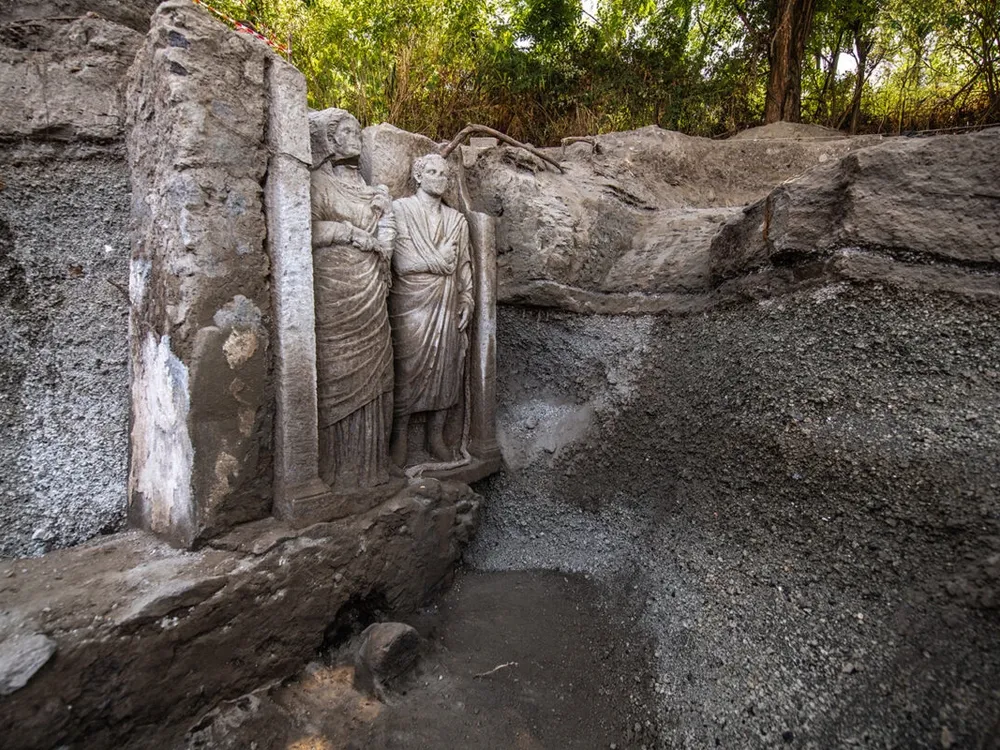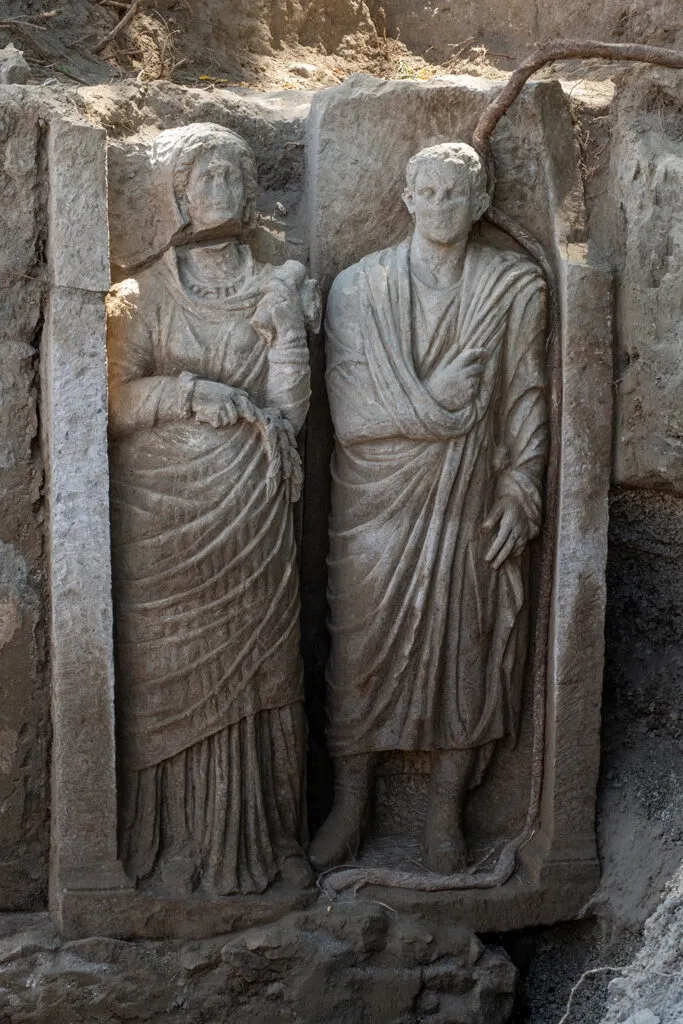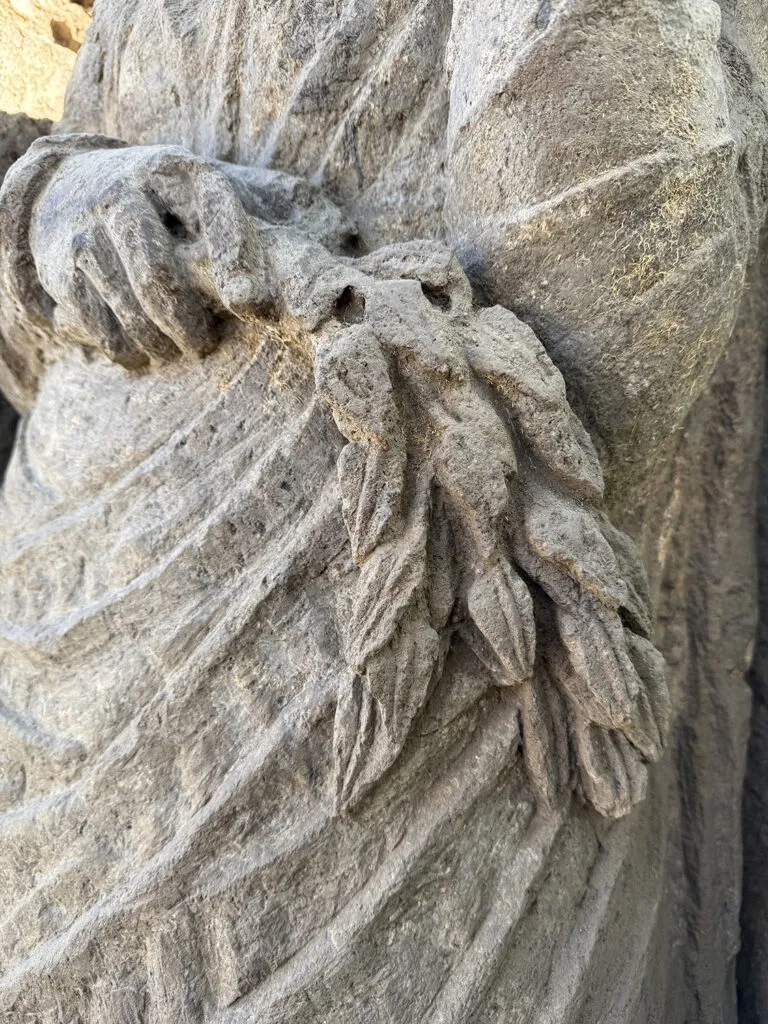
The sculptures seem to portray a wedded pair. Scholars suggest the female figure, depicted holding laurel leaves, might have served as a priestess.
Two statues, nearly matching life-size proportions, have been unearthed within a burial site at Pompeii, the ancient Roman settlement obliterated by Mount Vesuvius’ catastrophic eruption in 79 C.E. Specialists interpret the figures as a funerary relief illustrating a couple interred at the location.
These sculptures embellish a tomb wall situated in a necropolis close to Porta Sarno, one of the principal city gates of Pompeii, as per an official release from the Pompeii Archaeological Park. The burial ground predominantly comprises cremation interments. Incorporated into the tomb’s surface are multiple niches, historically used for funerary urns, in addition to a sculptural relief displaying a man and woman standing adjacent to each other.
According to an article in the park’s digital journal, the artwork likely originated during the Late Republican era of Rome (spanning the second to first century B.C.E.). Tombs exhibiting such characteristics are notably uncommon in the southern Italian region.

The academic consensus posits that the sculpted figures symbolize a married couple, although definitive identification remains elusive. “This could be her husband, but it could also be her son,” stated Gabriel Zuchtriegel, director of the archaeological park, in conversation with Angela Giuffrida of The Guardian. “There was no inscription, so we don’t know.”

The male figure is shown wearing a modest toga, while the female is clad in a voluminous cloak layered over a tunic and adorned with numerous ornamental items. Her carved adornments feature amphora-shaped earrings, a wedding ring, bracelets, and a necklace bearing a Lunala pendant (a crescent-shaped symbol). Historically, Roman girls wore Lunala amulets until their marriage as a means of safeguarding themselves from malevolent influences.
In her right hand, the woman holds laurel leaves, which were traditionally employed by Roman priests and priestesses to sanctify ceremonial spaces. Her left-hand clasps a cylindrical object, presumed to symbolize a scroll.
“She truly presents herself as a very important figure within the local aristocracy,” Zuchtriegel told The Guardian. “There’s also this prevailing theory that she might have been a priestess of Ceres, given the botanical elements and what seems to be a papyrus roll.”
Ceres, revered in Roman mythology as the goddess overseeing agriculture, fertility, and motherhood, held strong symbolic ties with the moon, as lunar phases were believed to mirror agricultural cycles. This belief could elucidate the inclusion of the lunula pendant on the female sculpture, as noted in the publication.
“Since women in Roman society were predominantly confined to domestic roles and expected to embody the ideals of the Roman matron, attaining the role of priestess represented the highest social elevation accessible to them,” the scholars explain.
Functioning as officiants in religious cults, priestesses “would have conducted rituals within temples and participated in processions honoring Ceres,” stated Sophie Hay, a British archaeologist affiliated with excavations in Pompeii, in a discussion with Nick Squires of The Telegraph. “Ceres was venerated not only as the deity of agriculture and cereals but also as a potent emblem of fertility and renewal. Her worship was widespread and revered.”
The antiquity and refined craftsmanship of these funerary reliefs already categorize them as rare archaeological discoveries. Nevertheless, the possibility that the female figure depicts a priestess in possession of ritualistic implements renders this find exceptional, according to the researchers. Moreover, the statue delivers crucial perspectives on the ritual life of ancient Pompeii’s citizens, furnishing compelling evidence that Ceres maintained a notable role in the formal religious practices of the city, supported by the existence of an ordained priestess.
Later this month, the funerary sculptures will be featured in an exhibit titled “Being a Woman in Ancient Pompeii” at the archaeological park. Visitors will have the opportunity to observe live sessions of experts engaged in the cleaning and preservation of these intricately crafted figures.
